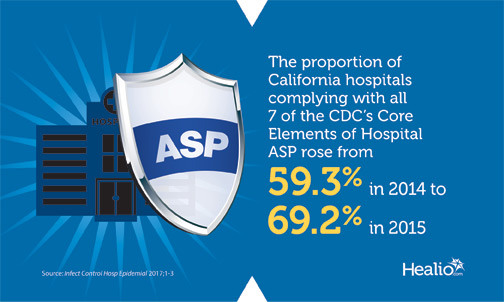More California hospitals implement CDC core antimicrobial stewardship measures under state law
The proportion of hospitals in California following all seven of the CDC’s core elements of antimicrobial stewardship programs, or ASPs, rose significantly between 2014 and 2015 after the passing of a state law requiring additional antimicrobial stewardship measures that comply with national guidelines, study data showed.
“In 2015, California Senate Bill 1311 mandated hospitals to implement additional antimicrobial stewardship practices,” Kyle Rizzo, MPH, of the Healthcare-Associated Infections Program at the California department of public health, and colleagues wrote. “Hospitals were required to institute an antimicrobial stewardship policy in accordance with guidelines established by the federal government and professional organizations, to develop a physician-supervised multidisciplinary antimicrobial stewardship committee with at least one physician or pharmacist who received prior stewardship training and to report antimicrobial stewardship activities to appropriate hospital committees.”
The researchers evaluated responses from California hospitals to the CDC’s National Healthcare Safety Network Annual Survey, which includes questions that correspond to the agency’s 7 Core Elements of Hospital Antibiotic Stewardship Programs. Rizzo and colleagues matched the questions with the agency’s guidelines to assess how antimicrobial stewardship programs changed after the implementation of the new state law.
Three hundred eighty-six of 388 hospitals in California completed their surveys in 2014 and 2015, the researchers reported. Of these, 284 were community hospitals (73.6%), 36 were major teaching hospitals (9.3%), 32 were critical access hospitals (8.3%), 23 were long-term acute care hospitals (6%) and 11 were pediatric hospitals (2.9%).
Nearly 90% of ASPs (88.9%; n = 343) implemented all infrastructure core elements in 2015, Rizzo and colleagues wrote, up from 78% (n = 301) in 2014 (P < .001). ASPs that had all infrastructure core elements in 2015 were more likely to have instituted all implementation core elements compared with those that did not have all infrastructure elements in place (RR = 2.4; 95% CI, 1.5-3.7), Rizzo and colleagues wrote.
Thirty-eight more ASPs had all seven core elements implemented in 2015 than in 2014 (increase, 16.6%; P < .001), the researchers reported. A total of 267 ASPs (69.2%) had all of the seven core elements in 2015, an increase from 229 in 2014. All hospitals reported implementing at least one core element in 2015.
“State and local health departments can perform similar analyses to inform outreach strategies that engage hospitals to sustain or improve their ASP,” the researchers wrote. “Public health efforts are needed to promote and advance antimicrobial stewardship practices in health care to address the urgent problem of antimicrobial resistance.” – by Andy Polhamus
Disclosures: The authors report no relevant financial disclosures.

